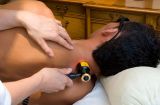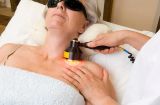Laser Pain Relief & Repair
infrared/ infrarouge


Couverture infrarouge et laser Thorlaser.com
La Thérapie au laser à basse intensité
Le laser doux a été conçu par une équipe spécialisée d’ingénieurs pour répondre aux besoins des patients d’aujourd’hui, offrant aux docteurs les résultats cliniques qu’ils désirent et aux patients la qualité de vie qu’ils méritent.
Contrairement aux lasers utilisés en chirurgie ou en esthétique, le laser thérapeutique n’émet aucune chaleur et ne peut donc pas endommager les tissus de la région traitée. Les faisceaux de lumière concentrée émis par l’appareil pénètrent cinq centimètres sous la peau et permettent une régénérescence des cellules, une diminution de l’inflammation et un soulagement de la douleur.
Ses applications sont multiples: en fait, toute douleur aiguë ou chronique de nature musculo-squelettique répond positivement et rapidement à la thérapie par laser et elle offre également de nouveaux espoirs pour les blessures sportives.
Notre traitement de la tendinite au laser doux est:
• Non-invasif ; non- chirurgical ; sans médicament.
• Supervisé par un professionnel de la santé, titulaire d’un doctorat.
• Approuvé par le FDA (2004).
• Doux : le traitement exige un léger contact avec la peau. Bien que certains patients éprouvent souvent une sensation de picotement presqu’imperceptible, le traitement n’est pas douloureux.
• Sécuritaire : la longueur d’onde des rayons lasers qui sont utilisés pour la stimulation des tissus n’ont pas suffisamment de force pour endommager les cellules. Les 30 ans d’études cliniques n’ont démontré aucun effet néfaste.
Quelle est la durée du traitement?
Le traitement au laser doux est d’une durée de 5 à 10 minutes pour chaque zone cible. Le nombre de traitements dépend de la gravité et l’historique de la blessure ou de la maladie. Le traitement est donné en petites quantités au fil du temps. Des améliorations sont en général notées dans un court laps de temps.
Les bienfaits thérapeutiques de la thérapie au laser doux :
• Agit au niveau cellulaire par biostimulation en stimulant les photorécepteurs des cellules, ce qui provoque des réactions biochimiques en cascade. Ces réactions biochimiques facilitent la lutte contre le processus inflammatoire et soulage la douleur grâce à la libération d’endorphines.
• Le laser doux peut accélérer la guérison du corps de plus de 10 fois son taux normal.
• Stimule le développement des fibroblastes et accélère la synthèse de collagène dans les tissus endommagés.
• Stimule la production de certaines enzymes spécifiques et contribue à l’augmentation de la perméabilité de l’oxygène et des éléments nutritifs à travers les membranes cellulaires, ce qui permet aux cellules d’absorber des éléments nutritifs et de se débarrasser des déchets métaboliques plus rapidement, résultant en guérison accélérée.
• Réduit l’excitabilité des tissus nerveux, ce qui diminue l’engourdissement associé à certaines conditions.
• Réduction de la formation des tissus fibreux : réduit la formation de tissu cicatriciel en augmentant la production de collagène
• Aide à réduire l’enflure (l’œdème) en augmentant la circulation lymphatique.
• Augmentation de la phagocytose : stimule l’évacuation des cellules endommagées par des blessures ou des conditions dégénératives. Ce nettoyage doit avoir lieu avant que la guérison puisse se produire.
Les athlètes utilisent maintenant le laser doux dans le cadre de leur stratégie d’entrainement, car ils peuvent diminuer le temps de récupération en augmentant la réparation des tissus après une séance d’entraînement intense. Les athlètes professionnels, tels que Lance Armstrong et les membres des équipes de football professionnelles comme les Patriotes de la Nouvelle-Angleterre se servent de la thérapie au laser doux pour le traitement de leurs blessures sportives.
Conditions traités grâce à la thérapie au laser doux :
Douleur aux articulations :
-Bursite
-Tendinite
-Entorse
-Inflammation
-Arthrose
-Arthrite
Le pied et les orteils:
-Fracture de fatigue métatarsienne
-Fasciite plantaire
-Épine de Lenoir
-Luxation
-Tendinite
Le genou:
-Déchirures ligamentaires
-Déchirures méniscales
-Syndrome fémoro-rotulien
-Tendinite
-Patella alta
-Entorse
-Osgood-Shlatter
Colonne vertébrale :
-Cervicalgie
-Dorsalgie
-Lombalgie
-Entorse cervicale, dorsale ou lombaire
-Whiplash (coup du lapin)
-Sciatique
-Syndrome facettaire
Blessures musculaires:
-Crampes
-Clacage musculaire (élongation)
-Contusion
-Syndrome de douleur myofaciale
La jambe:
-Syndrome de friction de la bandelette ilio-tibiale
-Périostite tibiale
-Tennis Leg
-Blessure à l’aine
L’épaule:
-Blessure à la coiffe des rotateurs
-Bursite
-Tendinite
-Capsulite
-Luxation
Le poignet :
-Syndrome du tunnel carpien
-Entorse
-Tendinite
-Ténosynovite de De Quervain
Blessures à la mâchoire :
-Luxation
-Ménisque
-Fracture
La cheville:
-Tendinite d’Achille
-Entorse de la cheville
La main et les doigts:
-Entorse
-Luxation
-Tendinite
-Fracture
Le coude:
-Tennis ou Golfer’s elbow (épicondylite)
-Luxation postérieure du coude
What is low-level laser therapy?
Also known as cold laser, low-level laser therapy is a form of photo-therapy used to stimulate tissue healing and provide pain management. The laser uses focused red and infrared light to stimulate tissue at and below the surface of skin to enhance the body’s natural healing processes.
The biological effect of the low-level laser increases the production of cellular energy and thus;
1) promotes cellular regeneration,
2) promotes collagen production for tissue repair,
3) increases blood flow for improved circulation.
Light from the low-level laser also encourages production of the body's natural pain-relievers.
How does low-level laser therapy work?
First of all, the acronym for L.A.S.E.R is “Light Amplification by Stimulated Emission of Radiation”. Laser technology has been around since the 1960’s and has many different applications in different industries.
At Brio Health Centre, we use the Bioflex Professional low-level laser therapy system approved by Health Canada and the FDA. This system is the safest and most effective low-level laser therapy system in North America. Our treatment methods provide a non-invasive, non-toxic and highly effective way to regenerate cells quickly, heal wounds, reduce pain, and restore normal cellular function.
When the body sustains an injury or develops arthritis, cells in that area begin to function poorly. Low-level laser therapy assists these injured cells by providing “photon energy” to stimulate normal cell function. Inside each of our cells is a power plant, called mitochondria,
that produces energy to fuel cell function. One such function is tissue repair, which requires a significant amount of energy.
At the site of injury, most cells are busy fighting inflammation and infection, leaving little energy for repair if the mitochondria are working at their usual rate. This is why certain tissues take a long time to repair on their own.
Low intensity light stimulates the mitochondria into hyperactivity so that they generate more energy than usual for cells to repair themselves. With the extra boost of energy, cells perform better, faster and more effectively. The result is enhanced and quicker wound and injury healing. The ability to combat infection and to restore blood circulation at the injury is also increased.
What conditions are most often treated with low-level laser therapy?
Low-level laser can be used to treat a myriad of conditions from wounds to sports injuries It is an amazing therapy for musculoskeletal injuries, soft tissue injuries (sprains and strains) and arthritis. It also helps to release tight muscles, stimulate nerve regeneration, reduce inflammation and aid in pain management.
Low-Level laser therapy is the treatment of Choice for the following ailments:
1) General:
Carpal Tunnel Syndrome
Tennis & Golfer’s Elbow
Repetitive Stress Syndrome
Rotator cuff injury
Temporo-mandibular joint dysfunction (TMJ)
2) Injuries:
Ligament and tendon tears
Fractures with associated soft tissue injuries
Contusions
Bulging and herniated discs
3) Inflammatory
Tendonitis
Bursitis
Plantar fasciitis
Rheumatoid Arthritis
4) Degenerative
osteoarthritis
Bone spurs
Spinal Stenosis
5) Other Applications
Wound Healing (acute & chronic)
Dermal ulcers caused by trauma, diabetes or poor circulation
Burns
Dermatological: Eczemas, Acne, Psoriasis, Herpes
Neurological:
Bell’s Palsy
Peripheral Nerve Damage
Gout/arthritis
lymphedema
Dermal scars (Keloid scars)
How can I benefit from low-level laser therapy?
If you sustained an injury, undergone orthopedic surgery, or suffer from arthritis or other painful conditions, you may be a candidate for low-level laser therapy. The low-level laser not only speeds the healing process but affects the overall quality of the repaired tissue. Muscle, tendon and ligament injuries require increased collagen production for successful healing and the low-level laser stimulates this function. The light also increases vascular growth and dilation for improved circulation in joints that may have limited movement. The biochemical effect of the low-level laser boosts the body's production of endorphins. Low-level laser therapy is another great way to treat the source of the pain, thereby making it less likely that you will need additional pain reducing medication.
What is the history of low-level laser therapy in healthcare?
The first low-level laser was developed in 1960 and early testing showed an increase in the speed and overall success of the healing process when it was used. Originally used for wound repair, clinical trials done throughout the 1970's showed the applicability of the low-level laser in therapy to be more widespread than previously thought. The 1990's came with the invention of more powerful and effective versions of the cold laser, eventually increasing its popularity in the field of rehabilitation.
How successful is low-level laser therapy?
Because low-level laser therapy has a cumulative effect, for best results treatments should be done at the frequency recommended by your health care team at Brio Health Centre. Low-level laser therapy is often recommended in conjunction with other modalities, such as
acupuncture and massage, to provide the best outcome.
How safe is low-level laser therapy?
Low-level laser therapy is very safe when done properly. To ensure that laser therapy is done only in cases where it is appropriate, an exam is first done by a physician at Brio Health Centre. The physician will then provide the specifics for the application of the cold laser. Although the term "laser" may conjure up images of the high-powered version sometimes used in surgical settings, the low-level laser causes no temperature change to the patient during or after the treatment and there is no risk of burning. Protective eye wear is required during application of the low-level laser and one should not look directly at the laser light. Laser therapy should not be used in certain patients with that are pregnant or that have cancer, as it stimulates cell growth and does not differentiate between healthy and cancerous cells.
How Long does a treatment take?
Treatments are typically 30 minutes to 60 minutes depending on the condition being treated.
How many Treatments are Required?
The average number of treatments required by patients is 8, but it varies from 3 to 20 treatments depending on the severity of the injury.
Are there any side effects?
Unlike most pharmaceutical solutions and other therapeutic options, laser therapy is non-toxic and non-invasive. No significant adverse effect have been noted in over 1 million individual treatments.
Can low-level laser therapy be combined with other types of treatments at Brio Integrative Health Centre?
Low-level laser therapy can be, and often is, combined with other types of modalities. Because low-level laser decreases pain and enhances circulation, your health care practitioner may choose to use the cold laser in conjunction with other forms of therapy to enhance the benefits of those therapies. Our experience shows that treatment outcomes are significantly improved when acupuncture, massage and the use of specific supplements are combined with low-level laser therapy. In general, low-level laser therapy integrates well into a treatment plan that utilizes either traditional or alternative forms of medicine.
